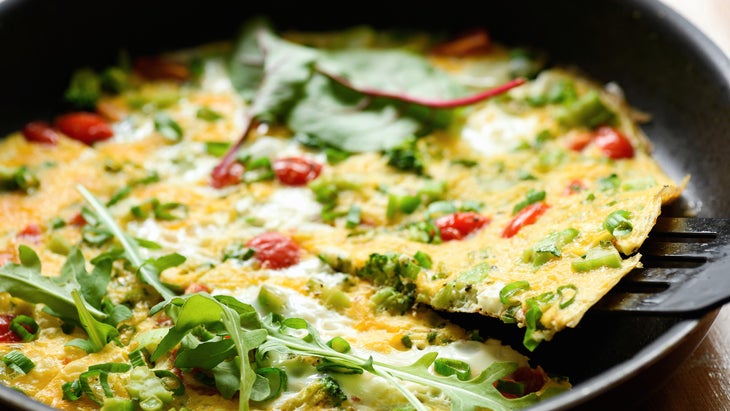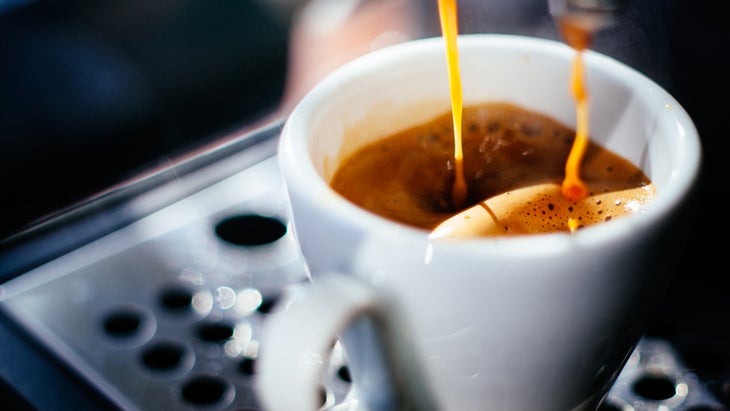Heading out the door? Read this article on the new Outside+ app available now on iOS devices for members! Download the app.
This isn’t the usual new-year-new-you diet article you’ve become so accustomed to reading. Indeed, diets spell the death of most weight-loss resolutions by the end of February because cookie-cutter meal plans lack personalization, sustainability and effectiveness: Maybe you don’t like eggs. Maybe you’re not a 180-pound male. Maybe you don’t have $300 a week to spend on groceries.
What follows here is not a blueprint of calorically perfect meals but rather a progressive 14-day set of fueling strategies you can implement to clean up your nutrition habits in 2021, no resolution required.
“Typically, people make too many changes at once and it’s too much to handle,” says Dana Angelo White, MS, RD, ATC, owner of Dana White Nutrition. “Big lifestyle changes are better tackled in small increments to set you up for long-term success.”
Adopt one of these food or lifestyle adjustments every day for two weeks and ease into 2021 like a boss — a super-lean, take-no-prisoners boss who makes performance nutrition look easy.
Day 1: Drink More Water
Adequate hydration is essential for proper metabolic function, and water assists in nearly every function in your body. It also keeps you full without adding calories to your daily total: A 2010 study in the journal Obesity found that individuals who consumed 16 ounces of fluids before a meal decreased the amount of food eaten at the meal, which led to greater weight loss as compared to individuals who didn’t consume the water.
DO THIS: Aim to drink half your bodyweight in ounces of water per day. Have a water bottle handy at all times, and set a timer on your phone to remind you to drink up.

Day 2: Break Your Fast — Sunny-Side Up
Researchers at Louisiana State University’s Pennington Biomedical Research Center found that those who ate eggs for breakfast were leaner and had fewer cravings than those who didn’t. Plus, the protein from eggs provides much-needed amino acids to repair and rebuild muscles as well as heart-healthy omega-3 fats from the vitamin-rich yolks. The perfect egg partners: slow-digesting carbs like oats and brightly colored fruits and veggies to add vitamins, antioxidants and physique-friendly fiber.
DO THIS: Schedule a set time for breakfast every day. Prep your food the night before, and make sure to include eggs with your meal to build muscle and reduce cravings.
Day 3: Chew Your Food
“This may sound like something your mom would tell you, but there’s good science behind it,” says Greg Nuckols of Stronger by Science. “When you chew your food more per bite, you’ll naturally eat [almost 15 percent] less per meal and still feel just as satiated.” Research published in The American Journal of Clinical Nutrition found that more chewing was associated with lower blood levels of ghrelin, a hormone that stimulates appetite, as well as higher levels of CCK, a hormone believed to reduce appetite.
DO THIS: Take a bite of food and notice how long you typically take to chew it. Then double that time to promote satiety and calorie control.

Day 4: Go to Bed
Nuckols continues his parental coaching: “Sleeping less than eight hours per night is associated with increased obesity risk, increases in ghrelin and decreases in leptin, which makes you feel full,” he says. “It’s easier to stick to a healthy eating plan and consume fewer calories if you’re not hungry all the time.”
DO THIS: Turn off your electronic devices, and get seven to nine hours of uninterrupted sleep per night.
Day 5: Go Whole Grain
Open your cabinet, take out all your refined grain products — bread, tortillas, pasta, pancake mix — and tote them to the nearest duck pond (well, maybe not the pancake mix). Then head to the store and replace that fare with whole-grain and whole-wheat products that taste great and slow digestion because of their high fiber and nutrient content. This means less of a negative impact on blood sugar and insulin release than their more refined counterparts.
DO THIS: Purchase products that say “whole wheat” or “whole grain” and that contain as few additives and preservatives as possible.
Day 6: Eat Your Weight — in Protein
If you’re training the way you should, maximizing recovery with protein is crucial. Protein supplies your body with amino acids, increasing your chance for gains in lean muscle, and therefore an increase in your metabolism and your ability to burn fat. Ingesting whole-food animal proteins is optimal because they present a complete amino-acid profile. But supplementing with powders such as whey, casein, soy, pea and even hemp protein are good, as well. You just have to augment your diet to fill gaps with critical muscle-friendly aminos like methionine and lysine.
DO THIS: Aim to consume at least 1 gram of protein per pound of bodyweight per day (on average), and strive to include protein in every meal and snack throughout the day.
Day 7: Plan Ahead
Lack of preparation and planning is the death knell of every resolution dieter, and the first time you head to the fridge hungry and realize you have to cook, the more likely you are to heat up that leftover pizza or head to the drive-thru. To stay focused and on track, you need to plan ahead and prepare plenty of healthy meals, snacks and lunches. Look at your upcoming schedule and see when and what you will need to cook ahead of time to make it through the week successfully. No time to cook? Microwaveable oatmeal (without sugar!), bagged salads, rotisserie chicken and ready-to-drink protein shakes are good in a pinch.
DO THIS: Take an afternoon to cook your healthy food in large batches, and portion it out into meals and snacks for a week.

Day 8: Get Your Jolt
According to research, the caffeine in brewed coffee boosts alertness, temporarily increases strength and assists in fat burning. Have your first fix at breakfast to start your day with a bang, and six hours later, have another hit 30 to 60 minutes before your first rep at the gym. As a longevity bonus, the European Society of Cardiology found that those who consumed four cups of antioxidant-loaded coffee per day had a 64 percent reduced chance of early death. For hard-training individuals, your ideal source for workouts is caffeine anhydrous, the most researched version of this wonder compound. Limit caffeinated coffee in the hours before bedtime to ensure optimal sleep, and allow several hours between helpings to avoid jitters.
DO THIS: Take in 200 to 300 milligrams of caffeine once or twice daily for performance benefits.
Day 9: Fish for Recovery (and Other Stuff)
Fish oil is a health and performance powerhouse that supports brain and joint health while boosting your fat-burning capabilities. Research published in The American Journal of Clinical Nutrition showed that those who took in 6 grams of fish oil per day while exercising dropped 1.2 percent body fat — in just 12 weeks!
DO THIS: Purchase a basic quality fish oil product and take it daily. In addition, aim for one or two servings per week of quality, “oily” fish like salmon, trout and tuna.
Day 10: Expand Your Antioxidant Menu
White says the importance of antioxidants for active individuals cannot be stressed enough. “They need to be a regular fixture in the diet to be effective at fighting inflammation and boosting immunity and skin and heart health,” she says. “The best sources are plant-based foods, fruits, vegetables, legumes and whole grains.”
DO THIS: When selecting your produce, reach for the brightest-skinned options: bell peppers, tomatoes, cranberries, raspberries and blueberries. Other produce such as kale and goji berries have been touted as “superfoods” for their per-gram antioxidant content.
Day 11: Learn to Snack Smart
You’ve probably heard that eating smaller meals throughout the day jacks your metabolism, but the science on meal frequency continues to evolve, with research showing that three- and six-meal-per-day eaters lost approximately the same amount of body fat overall in clinical trials. Rather than focusing on eating a set number of meals at a certain time, develop appropriate snacking habits so that you reach for the right things when hunger sets in to keep your metabolism revved and your cravings at bay.
DO THIS: Have low-sugar, protein-rich snacks available to you at all times. Think almonds, Greek yogurt, protein powder and hard-boiled eggs.

Day 12: Write On
Keeping a food journal helps you quantify your journey and adjust as necessary to reach your goals. Often, you won’t realize your nutritional weaknesses until you actually expose them on paper. Research published in the American Journal of Preventive Medicine found that those who kept a food journal — whether it was on paper or with an app or tracker — lost twice as much weight as those who did not keep track.
DO THIS: When you journal, enter everything you ingest, including water, carbs, protein and fat, as well as sodium and fiber. Also, notate how you’re feeling, and see what’s working and what’s not.
Day 13: Spud Up
One food that helps you stay full and happy — while also scoring high in general deliciousness — is the almighty potato. “A 1995 study that tested the satiating effects of 38 common foods found that boiled [white] potatoes were the most satiating item by far,” Nuckols says. “In fact, they were almost 50 percent more satiating than the next food down the list, the ling fish.” (Insert crickets chirping here.) Sweet potatoes and yams are also very filling and contain additional fiber to slow digestion as well as antioxidants.
DO THIS: A potato any time of the day could prevent a comfort-food binge. Drizzle cooked potatoes with some organic extra-virgin olive oil and a bit of pepper for a guilt-free craving crusher.
Day 14: Stop Eating … Seriously
Research published in the European Journal of Clinical Nutrition found that intermittent fasting — stretches of eight to 16 hours or more without eating — could help you lose 0.5 to 1.7 pounds per week while also improving body composition. And yes, this covers sleep time.
DO THIS: Once or twice per month for two consecutive days, try going 12 to 16 hours without food by passing on dinner, then having a reasonable breakfast. During the day on those two days, keep calories between 500 to 700, and your water consumption and workout schedule normal.